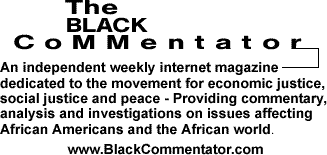
| Home |
Cover Story
New York’s Juvenile Prisons Are A Crime
Color of Law
By David A. Love, JD
BlackCommentator.com Editorial Board
If you can judge a society by the way it treats its children, then New York fails in a big way.� In fact, the Empire State should be found guilty of child abuse and neglect.
The New York Times recently reported on the deplorable state of New York�s juvenile justice system.� Gov. David Paterson appointed a task force to look into the matter.� A draft report prepared by the task force�a stinging indictment of the state�s treatment of juveniles in state custody�comes three months after a federal investigation found constitutional violations at four facilities.� The abuse was so severe, including broken bones, concussions, knocked-out teeth and other injuries, that the U.S. Department of Justice (DOJ) threatened to take over the prison system.
The task force was assembled as a result of years of complaints, and incidents such as the death of an emotionally-disturbed 15-year-old boy after he was pinned down by prison staff.� The bottom line is that New York�s juvenile centers are broken, expensive, unfair and a failure.
It is shocking that the state spends close to $210,000 per year to incarcerate a youth.� More than 1,600 juveniles enter the system each year.� In these days of budget cuts, shortfalls and economic triage, that is money that will not go to that child�s education and development.� What does the taxpayer, or the juvenile, for that matter, actually get for $210,000?� Not much, it appears.� Although the system was meant for those juveniles who are a danger to society if not themselves, there is no system to assess whether they are a risk to public safety.� Over half of the children are placed in these detention centers for misdemeanor offenses such as drug possession, truancy and theft.� And three-quarters of those youths who are released from custody return within three years.
Many of these children have problems that are not being addressed, including developmental disabilities, drug or alcohol addiction problems, and mental illness. But the facilities are understaffed, with only 55 psychologists and clinical social workers, and absolutely no psychiatrists that can prescribe medication.� Moreover, juveniles are locked up with violent adult criminals and susceptible to physical abuse, while staff use force as a form of discipline for the most minor infractions.
Race and the criminal justice system are inseparable, and the New York system is proof of that.� Blacks and Latinos are less than half of the state�s juvenile population.� Yet, at over 80 percent, black and Latino youth are the overwhelming majority of the occupants of its juvenile prisons.� And while seventy-six percent of these children come from the New York City area, they are imprisoned upstate, far away from their families, out of reach, and accessible only through a great expense.� With a median age of 16 and one-third of them reading on a third grade level, they have learned nothing in a school system that has failed them.� Not surprisingly, they receive no education in these centers.
�The DOJ report makes clear what many system stakeholders have been saying for a very long time: namely, that New York�s juvenile justice system is failing in its mission to nurture and care for young people in state custody,� the task force said of the previous federal investigation.� �The state�s punitive, correctional approach has damaged the future prospects of these young people, wasted millions of taxpayer dollars, and violated the fundamental principles of positive youth development.�� Further, the task force concluded that New York State is endangering the public by placing thousands of children in these facilities.�
The report concludes that institutionalizing youth should only be used as a last resort for small percentage of them, and to protect public safety.� In those cases, the goal should be to rehabilitate them, rather than harm or harden them.� Some of the recommendations made in the report include reducing the use of institutional placement; addressing the racial disparities; reinvesting in communities, expanding community-based alternatives to institutional placement; funding education and mental health treatment programs that prepare juveniles for release and reentry, and creating a system of transparency and accountability.
For those who are familiar with the dysfunction and inequities of the criminal justice system, this report should not be surprising. This author has no shortage of commentaries written on this very subject.� Nevertheless, this report should shock the conscience of expert and layperson alike.� In poor communities and communities of color, children are funneled through a cradle-to-prison pipeline, as the Children�s Defense Fund so effectively reported in recent years.� With a broken education and no employment opportunities, these children are being set up for a life behind bars.� Schools are a holding pattern for prisons, and with metal detectors and armed police with the power to arrest, many urban schools resemble prisons.� Society�s answer is to incarcerate more and more people, and to criminalize and punish at a younger age.� This tragic situation plays itself out throughout the nation, with the same results.� And as the nation with the world�s largest prison population, what does America have to show for it?�
Gov. Paterson�s task force report provides a warning not only to New York concerning its miserable juvenile justice system, but to other states as well.� And in the end, they should be applauded for finding constructive solutions to a problem that should concern us all.� In Pennsylvania, Illinois, Florida, California, Texas and everywhere else, no longer can we ignore the consequences of our inaction.
BlackCommentator.com Editorial Board member, David A. Love, JD is a journalist and human rights advocate based in Philadelphia, and a contributor to The Huffington Post, theGrio, The Progressive Media Project, McClatchy-Tribune News Service, In These Times and Philadelphia Independent Media Center. He also blogs at davidalove.com, NewsOne, Daily Kos, and Open Salon. Click here to contact Mr. Love.
| Home |


